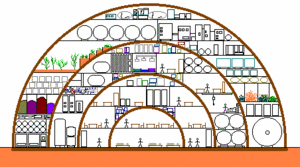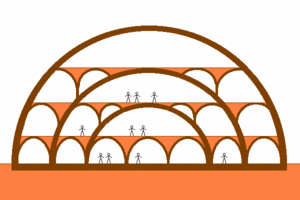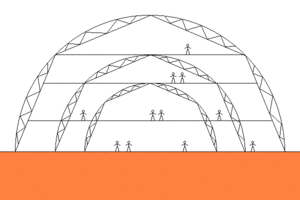Multi-layered vault settlement
|
v · d · eSettlement Types | ||||
|---|---|---|---|---|
A multi-layered vault settlement is a building, consisting of several shells. Each shell serves a different purpose: The central shell is the best protected part of the settlement, best useful for living rooms. The outermost shell contains store rooms, greenhouses, machinery, etc. It can be dome or barrel shaped.
Contents
Properties
Rectangular column, beam and girder design with steal structural members as used on Earth would not be appropriate on Mars for any structure intended for human habitation. On Mars the first need for a habitation is that it be a pressure vessel to hold in enough air pressure for human survival, so cylindrical and spherical buildings would be built. One option is to dig a semicircular cross section ditch and build a cylindrical building in the ditch with its axis horizontal. Structural tension members would wrap around the entire building; roof, wall and floor to hold air pressure in. Another option for brick construction is to have a flat slab floor semi cylindrical roof structure and enough fill material over the roof so that the weight of the fill holds in the air pressure in the building below without the need for tensile strength in the walls of the structure. About 30 feet of brick and fill would be required to provide the necessary pressure. The inner surface of the pressure vessel must be lined with gas a impermeable layer.
Buildings would be made to their design size when first built. There would be no particular advantage to building a new layer of habitation above a previous building because the previous pressure vessel would be wasted and a new outer pressure retaining layer would be required.
Material
Brick
Bricks from sintered regolith allow the construction of vaults without any further material if the building is for unpressurized storage. Gravity alone stabilizes the building. Neither reinforcement nor grout is necessary. However, for people to inhabit a structure on Mars it needs to retain atmospheric pressure.
Specialized bricks (e.g. arch segments) can be made for every vault radius and for special shapes. Advantage: The strength of a brick vault can be optimized. Disadvantage: The effort for manufacturing a great variety of bricks is high. A brick dome on Mars will require steel, fiberglass, or some other structural reinforcement strong in tension to hold in air pressure. It will be most economical to continue the tension members below ground level to form a fully spherical building with the hemispherical dome showing on top and the inverted dome section for a basement and sub basement.
Universal bricks allow different vault radius and shapes with only one sort of brick. Advantage: The manufacturing can be automated easily. Disadvantage: The strength of the masonry depends on the connection between the bricks. It is inevitably weaker than a vault from specialized bricks, for the pressure does not act perpendicular at the surface of each brick in most cases. The requirement for reinforcement material in the outermost wall to retain air pressure is the same as for other brick.
Steel
Steel allows the construction of a great variety of vault shapes. Since steel provides great strength even with thin girders, such vaults provide optimal space inside. Disadvantages: Steel is probably more expensive to produce than bricks.
Layers
Innermost layer
- Sleeping rooms
- Living rooms
Middle layer
- Working rooms
- Vital machinery
Outermost layer
- Storage of material and inventories
Open issues
- What is better for radiation shielding and protection against meteorites: A brick vault or a steel vault?
| Concepts: | Greenhouse · Settlements · Locations · General |
| Hazards: | Space Weather · Climate · General |
| Technology: | Hi-Tech · Lo-Tech · Energy · Spaceflight science · Communication · General |
| Human Considerations: | Economics · Health · Governance · Trade · Law · Social |











